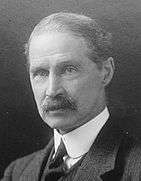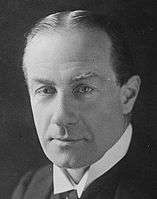Conservative government, 1922–1924
Baldwin led the Government through 1924. He resigned after losing a vote of confidence.
The Conservative government of the United Kingdom that began in 1922 and ended in 1924 consisted of two ministries: the first Law ministry (from October to November 1922), the second Law ministry (from November 1922 to 1923), and then the first Baldwin ministry (from 1923 onwards).
The government was led by Bonar Law and Stanley Baldwin, appointed respectively as Prime Minister of the United Kingdom by King George V.
Cabinets
Bonar Law's Cabinet, October 1922 – May 1923
- Bonar Law – Prime Minister and Leader of the House of Commons
- Lord Cave – Lord Chancellor
- Lord Salisbury – Lord President of the Council and Chancellor of the Duchy of Lancaster
- Stanley Baldwin – Chancellor of the Exchequer
- William Clive Bridgeman – Secretary of State for the Home Department
- Lord Curzon of Kedleston – Secretary of State for Foreign Affairs and Leader of the House of Lords
- The Duke of Devonshire – Secretary of State for the Colonies
- Lord Derby – Secretary of State for War
- Lord Peel – Secretary of State for India
- Lord Novar – Secretary for Scotland
- Leo Amery – First Lord of the Admiralty
- Sir Philip Lloyd-Greame – President of the Board of Trade
- Sir Robert Sanders – Minister of Agriculture and Fisheries
- Edward Frederick Lindley Wood – President of the Board of Education
- Sir Montague Barlow – Minister of Labour
- Sir Arthur Griffith-Boscawen – Minister of Health
Changes
- April 1923 – Griffith-Boscawen resigned as Minister of Health after losing his seat and was succeeded by Neville Chamberlain.
Baldwin's Cabinet, May 1923 – January 1924
- Stanley Baldwin – Prime Minister, Chancellor of the Exchequer and Leader of the House of Commons
- Lord Cave – Lord Chancellor
- Lord Salisbury – Lord President of the Council
- Lord Robert Cecil – Lord Privy Seal (Viscount Cecil of Chelwood from 28 December 1923[1])
- William Clive Bridgeman – Home Secretary
- Lord Curzon of Kedleston – Secretary of State for Foreign Affairs and Leader of the House of Lords
- The Duke of Devonshire – Secretary of State for the Colonies
- Lord Derby – Secretary of State for War
- Lord Peel – Secretary of State for India
- Sir Samuel Hoare – Secretary of State for Air
- Lord Novar – Secretary for Scotland
- Leo Amery – First Lord of the Admiralty
- Sir Philip Lloyd-Greame – President of the Board of Trade
- Sir Robert Sanders – Minister of Agriculture
- Edward Frederick Lindley Wood – President of the Board of Education
- Sir Anderson Montague-Barlow – Minister of Labour
- Neville Chamberlain – Minister of Health
- Sir William Joynson-Hicks – Financial Secretary to the Treasury
- Sir Laming Worthington-Evans – Postmaster-General
Changes
- August 1923 – Neville Chamberlain took over from Baldwin as Chancellor of the Exchequer. Sir William Joynson-Hicks succeeded Chamberlain as Minister of Health. Joynson-Hicks' successor as Financial Secretary to the Treasury was not in the Cabinet.
List of Ministers
Members of the Cabinet are shown in bold face.
References
- D. Butler and G. Butler (ed.). Twentieth Century British Political Facts 1900–2000.
- ↑ "No. 32892". The London Gazette. 28 December 1923. p. 9107.
- ↑ "No. 32828". The London Gazette. 29 May 1923. p. 3741.
- ↑ "No. 32835". The London Gazette. 19 June 1923. p. 4275.
- ↑ J C Sainty 'Assistant Whips 1922-1964' in Parliamentary History Vol 4 (1985) pp 201-04
| Preceded by Second Lloyd George ministry |
Government of the United Kingdom 1922–1924 |
Succeeded by First MacDonald ministry |
This article is issued from
Wikipedia.
The text is licensed under Creative Commons - Attribution - Sharealike.
Additional terms may apply for the media files.


.svg.png)